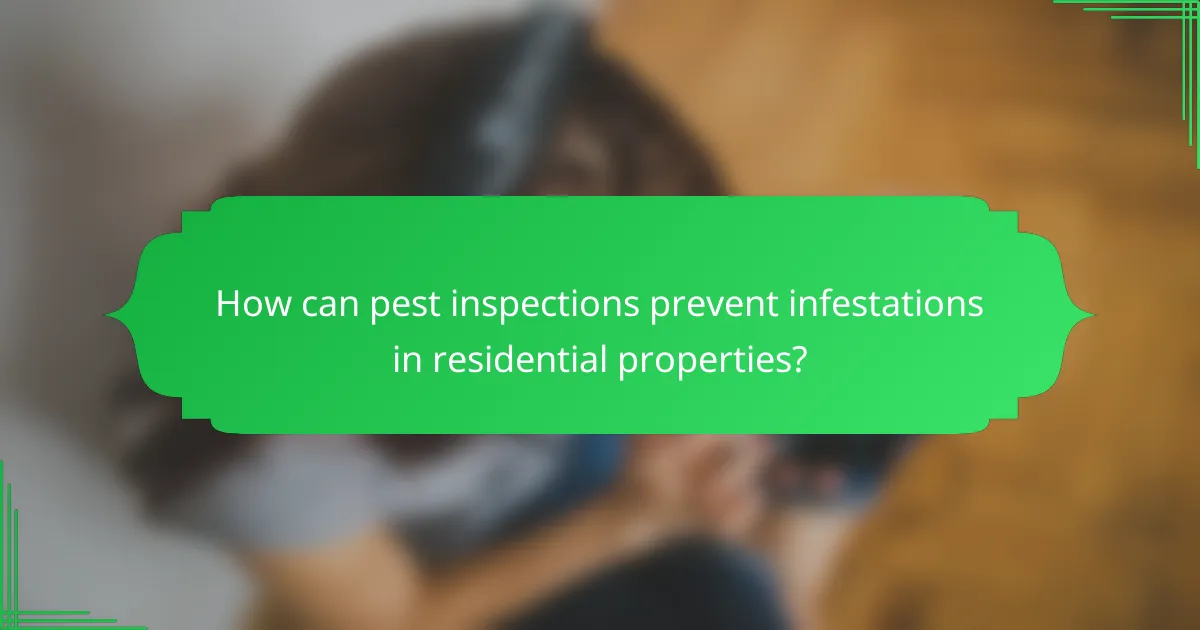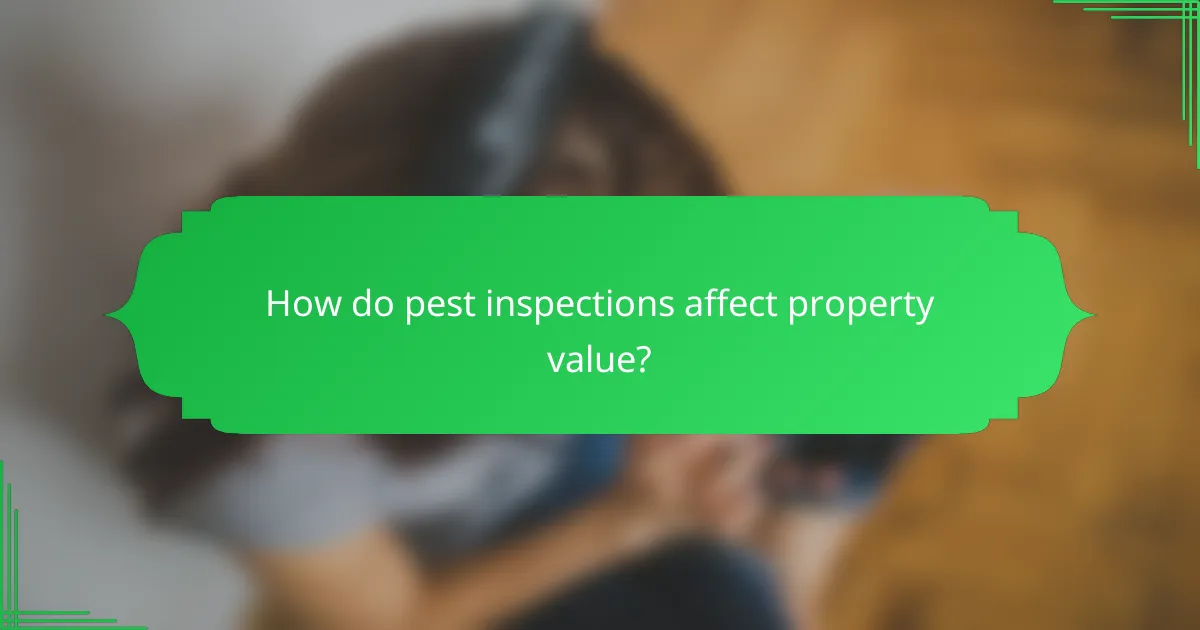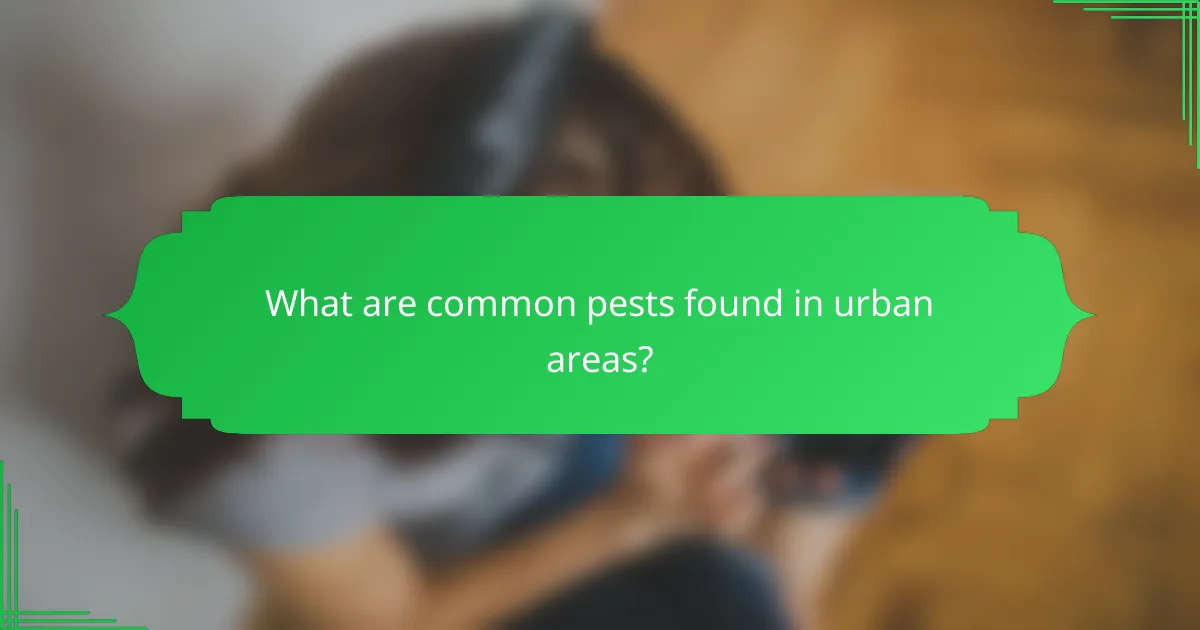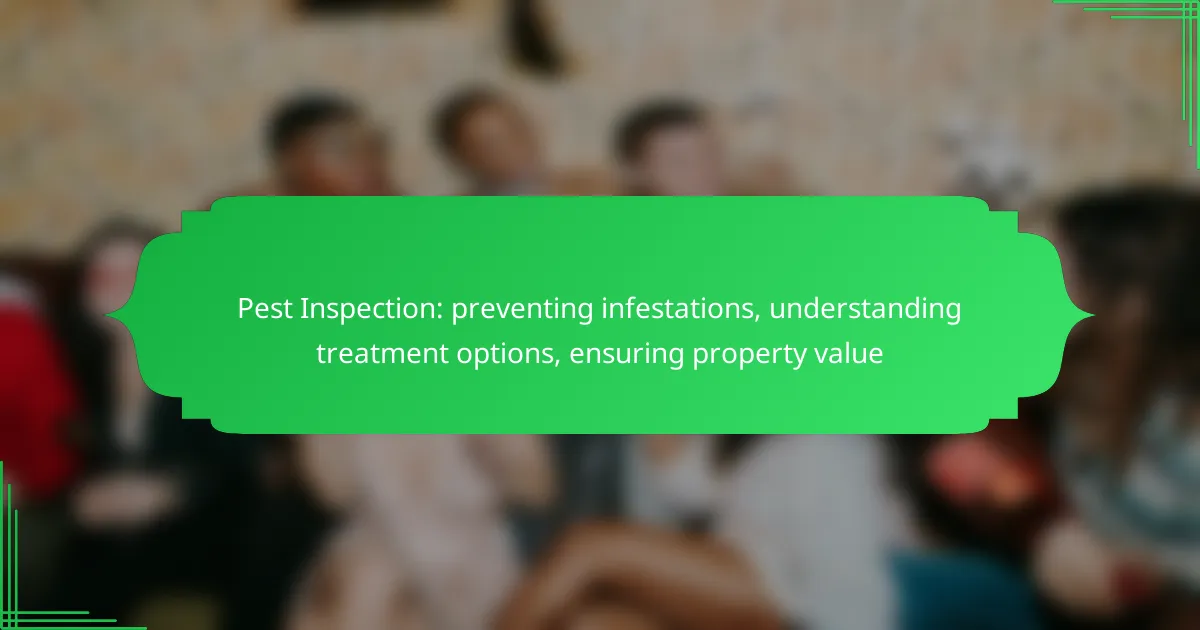Pest inspections play a crucial role in preventing infestations by identifying potential issues before they become serious problems. Regular inspections not only help maintain a pest-free environment but also protect property value and ensure a safe living space. Understanding the various treatment options available is essential for effectively addressing any pest concerns that may arise.

How can pest inspections prevent infestations in residential properties?
Pest inspections are essential for preventing infestations in residential properties by identifying potential pest problems before they escalate. Regular inspections help homeowners maintain a pest-free environment, which protects their property value and ensures a safe living space.
Early detection of pests
Early detection of pests is crucial in preventing infestations. Professional inspectors can identify signs of pest activity, such as droppings or nesting materials, before they become a larger issue. This proactive approach allows for timely intervention, reducing the risk of extensive damage and costly treatments.
Homeowners should consider scheduling inspections at least once a year, especially in regions prone to specific pests like termites or rodents. Early detection not only saves money but also minimizes disruption to daily life.
Identification of conducive conditions
Pest inspections help identify conducive conditions that may attract pests to a property. Factors such as moisture, food sources, and shelter can create an inviting environment for pests. Inspectors assess these conditions and provide recommendations to mitigate risks.
For example, sealing cracks, fixing leaks, and removing clutter can significantly reduce the likelihood of infestations. Homeowners should be aware of these conditions and take preventive measures to maintain a pest-resistant property.
Regular monitoring and maintenance
Regular monitoring and maintenance are key components of effective pest management. After an initial inspection, ongoing monitoring can help detect new pest activity early. This may involve periodic follow-up inspections or setting up traps in vulnerable areas.
Homeowners should establish a maintenance routine that includes checking for signs of pests and addressing any conducive conditions. This proactive strategy not only prevents infestations but also preserves the overall integrity and value of the property.

What are the treatment options for pest infestations?
There are several effective treatment options for pest infestations, including chemical treatments, biological control methods, and Integrated Pest Management (IPM). Each option has its own advantages and considerations, making it essential to choose the right approach based on the specific pest problem and property context.
Chemical treatments
Chemical treatments involve the use of pesticides to eliminate pests quickly. These products can be applied as sprays, baits, or granules, and are often effective against a wide range of insects and rodents.
When using chemical treatments, it’s crucial to follow safety guidelines and local regulations regarding pesticide application. For example, in the EU, specific regulations govern the use of certain chemicals to protect human health and the environment.
Consider hiring a licensed pest control professional to ensure proper application and minimize risks. Always read labels carefully and store chemicals safely away from children and pets.
Biological control methods
Biological control methods utilize natural predators or parasites to manage pest populations. This approach can be environmentally friendly and sustainable, as it reduces reliance on synthetic chemicals.
Examples of biological control include introducing ladybugs to control aphid populations or using nematodes to target soil-dwelling pests. These methods often take longer to show results but can lead to a balanced ecosystem.
When considering biological control, research the specific pests and their natural enemies to ensure compatibility and effectiveness. This method is best suited for gardens and agricultural settings.
Integrated Pest Management (IPM)
Integrated Pest Management (IPM) is a comprehensive approach that combines multiple strategies to manage pest infestations effectively. IPM focuses on prevention, monitoring, and control, using the least harmful methods first.
Key components of IPM include regular inspections, identifying pest thresholds, and implementing a mix of cultural, mechanical, biological, and chemical controls. This method aims to minimize risks to human health and the environment while maintaining effective pest management.
For successful IPM, property owners should educate themselves about pest behaviors and maintain good sanitation practices. Regular monitoring and adapting strategies based on pest activity are essential for long-term success.

How do pest inspections affect property value?
Pest inspections can significantly influence property value by identifying potential infestations and damage before they escalate. A thorough inspection can reassure buyers and help sellers maintain or enhance their property’s marketability.
Impact on resale value
The resale value of a property can be adversely affected by pest issues. Homes with a history of infestations or visible damage may sell for tens of percent less than comparable properties without such issues. Addressing pest problems before listing can help preserve or even increase the property’s value.
Investing in pest control prior to selling can yield a better return, as buyers are often willing to pay more for homes that are pest-free. A clean inspection report can serve as a strong selling point.
Insurance considerations
Pest inspections can also impact insurance premiums and coverage options. Many insurance companies require a pest inspection before issuing a policy or may offer lower rates for properties with a clean inspection history. Conversely, properties with known pest issues might face higher premiums or limited coverage.
Understanding your insurance policy’s requirements regarding pest control can help you avoid unexpected costs. Regular inspections can also prevent claims related to pest damage, which can affect future insurability.
Buyer confidence
Buyer confidence is crucial in real estate transactions, and pest inspections play a key role in fostering that trust. A clean inspection report can reassure potential buyers that the property is well-maintained and free from hidden issues. This can lead to quicker sales and potentially higher offers.
On the other hand, if a property shows signs of pest problems, buyers may hesitate or offer significantly lower prices. Being proactive with pest inspections can enhance buyer perception and facilitate smoother negotiations.

What criteria should be used to choose a pest inspection service?
When selecting a pest inspection service, consider their certifications, customer feedback, and service guarantees. These factors ensure the company is reputable, skilled, and committed to customer satisfaction.
Certifications and qualifications
Verify that the pest inspection service holds relevant certifications and licenses required in your area. In the United States, for example, many states require pest control operators to be licensed and may have specific training requirements.
Look for affiliations with professional organizations, such as the National Pest Management Association (NPMA) or local pest control associations. These memberships often indicate adherence to industry standards and ongoing education.
Customer reviews and testimonials
Examine customer reviews and testimonials to gauge the quality of service provided by the pest inspection company. Online platforms like Google, Yelp, or Angie’s List can offer insights into customer experiences and satisfaction levels.
Pay attention to patterns in feedback, such as responsiveness, thoroughness of inspections, and effectiveness of treatments. A company with consistently positive reviews is likely to deliver reliable service.
Service guarantees
Inquire about service guarantees offered by the pest inspection service. A strong guarantee can provide peace of mind, indicating that the company stands behind its work and is willing to address any issues that arise after the inspection.
Common guarantees include follow-up visits or free re-inspections if pests return within a specified timeframe. Understanding these terms can help you make an informed decision and protect your property investment.

What are common pests found in urban areas?
Urban areas often host a variety of pests that can damage property and impact health. Common pests include termites, rodents, and bed bugs, each requiring specific prevention and treatment strategies.
Termites
Termites are wood-destroying insects that can cause significant structural damage to homes and buildings. They thrive in warm, moist environments and often go unnoticed until extensive damage has occurred.
To prevent termite infestations, ensure that wood is not in direct contact with soil, fix leaks promptly, and maintain proper drainage around your property. Regular inspections by pest control professionals can help identify early signs of termite activity.
Rodents
Rodents, such as rats and mice, are common in urban settings and can contaminate food and spread diseases. They typically enter buildings through small openings and can reproduce rapidly, leading to larger infestations.
To deter rodents, seal entry points, keep food stored in airtight containers, and maintain cleanliness in and around your property. Setting traps or using bait stations can effectively manage existing populations.
Bed bugs
Bed bugs are small, blood-sucking insects that often hide in mattresses and bedding. They can cause itchy bites and significant discomfort, making them a nuisance in homes and hotels alike.
Prevent bed bug infestations by inspecting second-hand furniture before bringing it home, using protective mattress covers, and regularly washing bedding in hot water. If an infestation occurs, professional extermination is often necessary to eliminate these pests completely.
